
|
a web page by Don
Roberson
|
|
COTINGAS
Cotingidae
|
|||
|
|||
|
Most cotingas feed almost exclusively on fruit. In rich tropical forests with plenty of year-round fruit, male cotingas — like male Birds-of-Paradise of New Guinea — have evolved some of the most spectacular and colorful plumages in the world. Males mostly display and vocalize, while females wear unobtrusive green or brown plumages, and raise the young on their own. Male cotingas sport contrasting patterns that can be plushly scarlet, brilliant blue, amazingly white (genus Carpodectes), burgundy and white (genus Xipholena) or contrasting black-and yellow, such as Black-and-gold Cotinga of the Atlantic forests of southeast Brazil (below).
|
|||
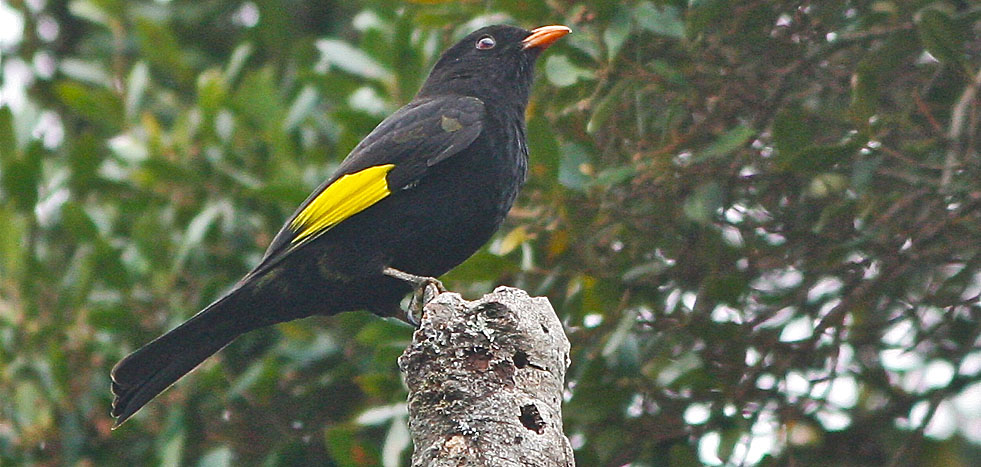 |
|||
|
|||
|
It is theorized that when birds evolve in a habitat that has an abundance of food, especially an abundance of fruit, some may evolve lekking behavior, especially where nesting is not tied to seasonality (as in the tropics). Females visit the lek, and the female choices for mates can evolve spectacularly ornamental male plumages (Snow 1982, 2004). This explains the gaudy birds-of-paradise in Australasia, and explains strikingly red/orange male Cocks-of-the-Rock, or such lovely black-and-red species such as Black-necked Red Cotinga Phoenicircus nigricollis — also among my choices as one of the "best birds of the world" — or its relatives, Guianan Red Cotinga P. carnifex and Crimson Fruitcrow Haematoderus militaris. The unique Capuchinbird Perissocephalus tricolor of eastern Venezuela and the Guianas has a similar, elaborate mating system with males calling and display high in the subcanopy of tall rainforest. Yet others in the lineage have evolves quite different breeding systems. Purple-throated Fruitcrow, for example, lives in small parties of 3-8 birds, presumably related, and all attend the single nest. Then there are monogamous species, in which there is little sexual dimorphism in plumage: the fruit-eaters, Phytotoma plantcutters, and Swallow-tailed Cotinga Phibalura flavirostris. In these species both male and female construct the nest; the female incubates the eggs; and then both sexes actively feed the young. Embryonic development rates are rather slow. So much tropical forest — so many strategies! |
|||
|
Each of the four Procnias bellbirds are a great find within its limited habitat. Males give these advertising calls from high in a treetop, and, if I can use my birds-of-paradise analogy again, recalling very specialized birds-of-paradise — e.g., Twelve-wired Bird-of-Paradise, Wallace's Standardwing — wherein females mate with the calling male on the best perch. Two of the bellbirds — Three-wattled Bellbird Procnias tricarunculatus and White Bellbird P. albus — sport long bill and facial wattles. Bearded Bellbird has an abundance of shorter, more slender throat wattles. Montane bellbirds and umbrellabirds appear to move upslope to breed but move down-slope in a non-breeding season to exist in lowlands with more fruit. |
|||
Other well camouflaged cotingas are the ten fruiteaters (Pipreola), most garbed in exquisite but non-conspicuous greens and yellows, and two berryeaters (Carpornis), black-hooded above brown-and-yellow bodies. These sit quietly for periods of time. One piha is now considered critically endangered: Chestnut-capped Piha Lipaugus weberi, which was discovered in Colombia's Central Andes as recently as 1999 (Cuervo et al. 2001). It's cloud forest habitat within a narrow elevational range (1500-1820 m) is suffering on-going cutting and fragmentation. |
|||
All the cotingas in this genus are are quiet and may sit motionless for periods of time. They prefer the higher strata of the forest — even sitting on branches above the canopy — but little is known about their behavior, social organization and breeding. The few nests discovered have been high in the canopy, sometimes within an epiphyte. They don't give calls. It seems obvious that females may prefer to most colorful males, but their breeding strategies have not been studied. Birders, though, certainly seek to see the lovely males. Banded Cotinga Cotinga maculata is the largest and most range-restricted among this genus. Endemic to the lowland Atlantic Forest of Brazil, extensive habitat loss and fragmentation has led to serious declines. Fewer than 1500 are scattered across a few of reserves in eastern Brazil; it is now listed as critically endangered |
|||
|
There had once been much uncertainty about the composition of the Cotingas, and especially since some "difficult" groups seem to show some cotingid characters but also have similarities to Tyrant Flycatchers or Manakins. Included in this "difficult" group were "traditional" cotingids such as purpletufts (genus Iodopleura) and Shrike-like Cotinga, sometimes called Elegant Mourner (Laniisoma elegans), as well as the "Schiffornis group" of mourners, becards, and tityras (e.g., Prum & Lanyon 1989, Sibley & Ahlquist 1990). Recent molecular evidence has proved that most of these "difficult" taxa are members of a new family, the Tityridae (Ericson et al. 2006). This leaves the rest of the Cotingas as a solid monophyletic group (Ohlson et al. 2007). Too many cotingas are rare and endangered, including the recently discovered Chestnut-bellied Cotinga Doliornis remseni of the central Andes of Colombia and Ecuador. It is named for one of my mentors, J. Van Remsen (Robbins et al. 1994). The world of the cotingas is vast and wonderful and full of marvels, some of them with as yet little explanation. A fabulous introduction is in either of the monographs by David Snow (1982, 2004). I hope to have the opportunity to search out many more of them. Of all the families in the world, several groups of suboscine passerines seem, to me, to be the "heart" of the tropical rainforest. In Asia and Africa, it is pittas and broadbills; in the Neotropics, these include cotingas and manakins. Each successful encounter is a memory to be treasured. |
|||
|
|||
|
Photos: The male Andean Cock-of-the-Rock Rupicola peruvianus was at Afluente, San Martin, Peru, on 25 Nov 2015. The Black-and-Gold Cotinga Lipaugus ater was in foothill forest near Itatiaia NP, Brazil, on 5 Aug 2010. The male Purple-throated Fruitcrow Querula purpurata was near Lajas Blanca, Darién, Panama, on 13 Feb 2022. The male Red-ruffed Fruitcrow Pyroderus scutatus was at Itatiaia NP, Brazil, on 6 Aug 2010. The calling male Bearded Bellbird Procnias averano was at Asa Wright Nature Center on Trinidad on 23 Dec 2006. Arthur Grosset photographed the Screaming Piha Lipaugus vociferans at Thaimaçu Lodge, Pará, Brazil in April 2003. The male Blue Cotinga Cotinga nattererii was on Cerro Azul, Panama, on 17 Feb 2022. The distant, back-lit shot of Red-crested Cotinga Ampelion rubrocristatus was near Cusco, Peru, in June 1987 (digitized from slide).
Family Book — Rating:
Literature cited:
|
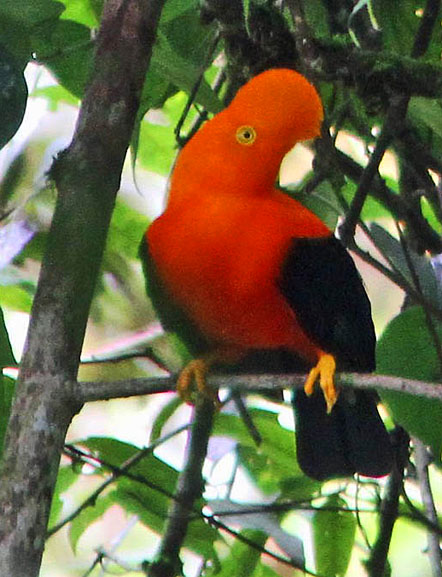 One of most interesting groups in
the Neotropics are the Cotingas. There is such color, such diversity,
just so many absurd birds that I think of them as the
"birds-of-paradise" of the New World. The most spectacular of all may
be the two species of cock-of-the-rock, both living in lush subtropical
forests, one in the Andes and one on the Guianan plateau. This is a male Andean
Cock-of-the-Rock (left). Males display in leks to much drabber
females. An excellent paper on the display of the Guianan species is in
Trail (1985). I rank both cock-of-the-rocks as among the "
One of most interesting groups in
the Neotropics are the Cotingas. There is such color, such diversity,
just so many absurd birds that I think of them as the
"birds-of-paradise" of the New World. The most spectacular of all may
be the two species of cock-of-the-rock, both living in lush subtropical
forests, one in the Andes and one on the Guianan plateau. This is a male Andean
Cock-of-the-Rock (left). Males display in leks to much drabber
females. An excellent paper on the display of the Guianan species is in
Trail (1985). I rank both cock-of-the-rocks as among the "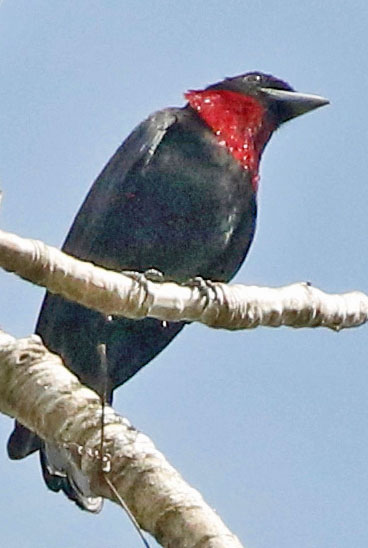
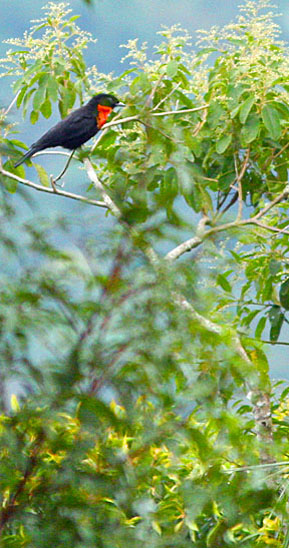
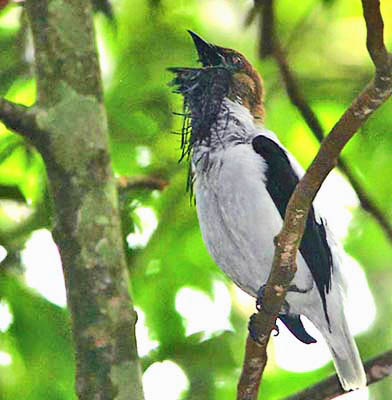 The Procnias bellbirds are
predominately white, or a mix of white, black, and brown. These amazing birds produce clarion, hammer-like cries than can to heard of miles. Among them is Bearded Bellbird
of northern South America and Trinidad (left). A male in full cry emits a loud, explosive, metallic "bock!"
The Procnias bellbirds are
predominately white, or a mix of white, black, and brown. These amazing birds produce clarion, hammer-like cries than can to heard of miles. Among them is Bearded Bellbird
of northern South America and Trinidad (left). A male in full cry emits a loud, explosive, metallic "bock!"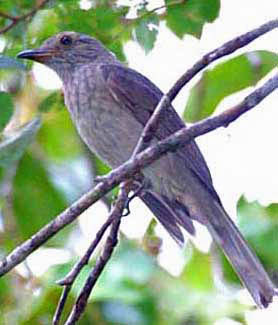 Bellbirds are not the only cotingid to be memorable for its vocalizations. The voice of the Screaming
Piha (right in a nice Arthur Grosset photo) IS the voice
of the South America lowland rainforest. It is so loud and explosive
that it becomes almost annoying to a birder: a semi-ventriloqual "weee,
wee, weee-ah!" Ridgley & Tudor (1994) say that is is "perhaps the
best-known sound of Amazonia (it is a familiar background sound even on
movie soundtracks), and it carries so far that in many regions one is
almost always within earshot." The bird itself, though, is extremely
hard to see in the leafy canopy. This is true of all 9 pihas (in two genera), whose drab plumage is difficult to spot in the back-lit overhead canopy.
Bellbirds are not the only cotingid to be memorable for its vocalizations. The voice of the Screaming
Piha (right in a nice Arthur Grosset photo) IS the voice
of the South America lowland rainforest. It is so loud and explosive
that it becomes almost annoying to a birder: a semi-ventriloqual "weee,
wee, weee-ah!" Ridgley & Tudor (1994) say that is is "perhaps the
best-known sound of Amazonia (it is a familiar background sound even on
movie soundtracks), and it carries so far that in many regions one is
almost always within earshot." The bird itself, though, is extremely
hard to see in the leafy canopy. This is true of all 9 pihas (in two genera), whose drab plumage is difficult to spot in the back-lit overhead canopy. 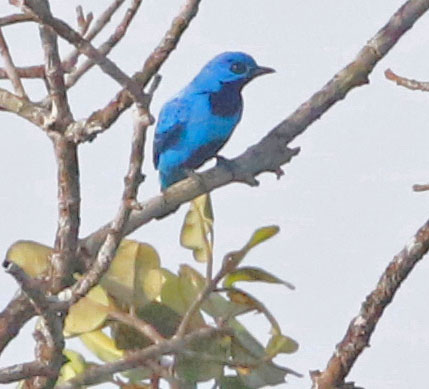 The Cotingidae also features a spectacular set of seven "blue cotingas" in the genus Cotinga. Males are varying shades of blue, tortoise, or purple; several species are blue with patches of purple, such as this male Blue Cotinga (left), which ranges from eastern Panama to northwestern Colombia and Ecuador. Females and young are drab buff, brown, or grayish.
The Cotingidae also features a spectacular set of seven "blue cotingas" in the genus Cotinga. Males are varying shades of blue, tortoise, or purple; several species are blue with patches of purple, such as this male Blue Cotinga (left), which ranges from eastern Panama to northwestern Colombia and Ecuador. Females and young are drab buff, brown, or grayish. 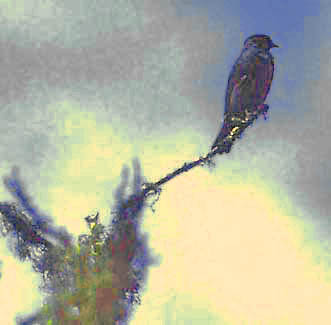 There are a few other cotingids that sit out
in the open, beyond the "blue cotingas, and these include the Red-crested Cotinga of the
high Andes (right). It incorporates some flying insects into its
diet, and snaps both fruit and bugs during short sallies. As previously noted, most of the
"core" cotingids are almost exclusive fruit-eaters.
There are a few other cotingids that sit out
in the open, beyond the "blue cotingas, and these include the Red-crested Cotinga of the
high Andes (right). It incorporates some flying insects into its
diet, and snaps both fruit and bugs during short sallies. As previously noted, most of the
"core" cotingids are almost exclusive fruit-eaters. 